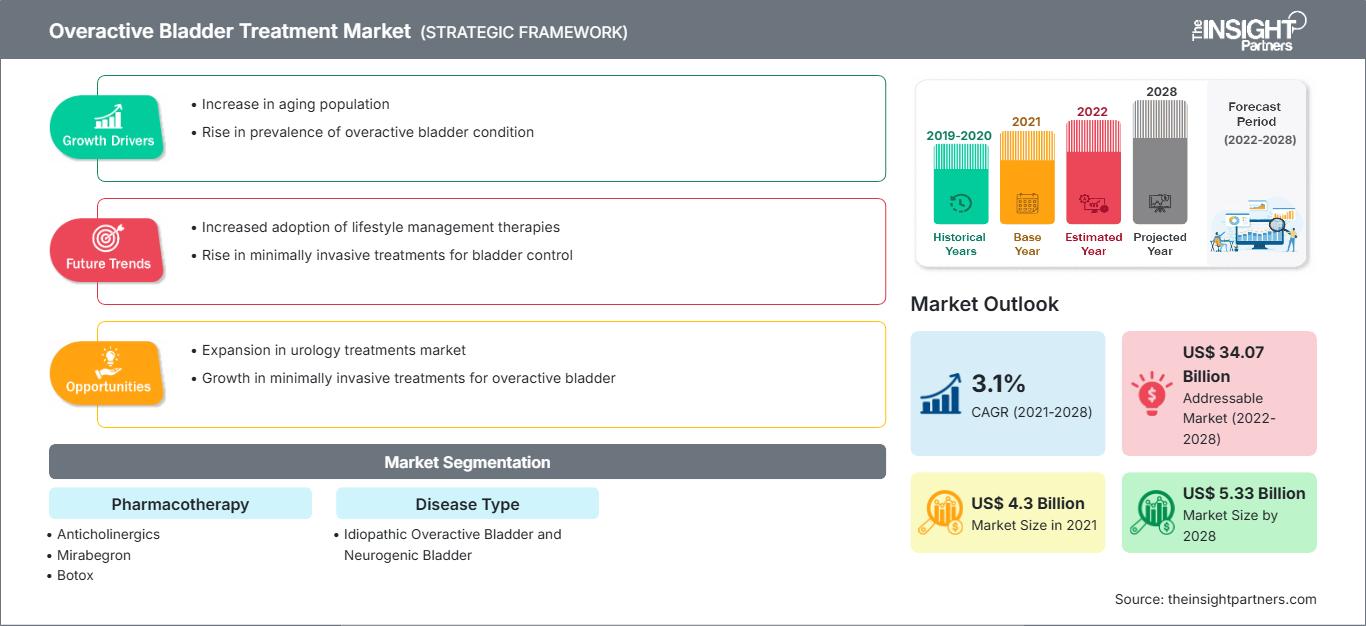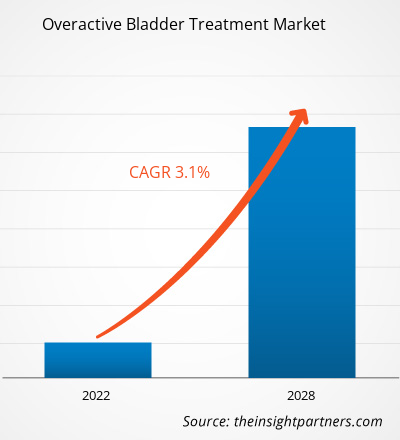Le marché du traitement de l'hyperactivité vésicale devrait passer de 4 295,93 millions de dollars américains en 2021 à 5 333,92 millions de dollars américains en 2028 ; sa croissance devrait atteindre un TCAC de 3,1 % entre 2022 et 2028.
L'hyperactivité vésicale (HV) se caractérise par une envie fréquente et soudaine d'uriner, qui peut être difficile à contrôler. Elle peut être causée par un traumatisme abdominal, une infection, une lésion nerveuse et la prise de certains médicaments. L'HV est fréquente chez les personnes de 65 ans et plus. Les femmes peuvent en souffrir après 45 ans. Le traitement comprend la modification de certains comportements, la prise de médicaments et la stimulation nerveuse.
Le marché du traitement de l'hyperactivité vésicale est segmenté en pharmacothérapie, type de maladie et zone géographique. Par zone géographique, le marché est largement segmenté en Amérique du Nord, Europe, Asie-Pacifique, Moyen-Orient et Afrique, et Amérique du Sud et centrale. Le rapport sur le marché du traitement de l'hyperactivité vésicale offre des informations et une analyse approfondie du marché, en mettant l'accent sur des paramètres tels que les tendances du marché, la dynamique du marché et l'analyse concurrentielle des principaux acteurs du marché mondial.
Personnalisez ce rapport en fonction de vos besoins
Vous bénéficierez d’une personnalisation sur n’importe quel rapport - gratuitement - y compris des parties de ce rapport, ou une analyse au niveau du pays, un pack de données Excel, ainsi que de profiter d’offres exceptionnelles et de réductions pour les start-ups et les universités
Marché du traitement de l'hyperactivité vésicale: Perspectives stratégiques

-
Obtenez les principales tendances clés du marché de ce rapport.Cet échantillon GRATUIT comprendra une analyse de données, allant des tendances du marché aux estimations et prévisions.
Aperçu du marché
Selon les données de la National Association for Incontinence, en 2018, environ 200 millions de personnes dans le monde étaient touchées par l'incontinence urinaire. L'incontinence d'effort et l'incontinence par impériosité sont les deux types courants d'incontinence urinaire chez les femmes, cette dernière étant également connue sous le nom d'hyperactivité vésicale. De même, une étude menée par un groupe de chercheurs de l'American College of Physicians et de l'Infectious Diseases Society of America en 2020 a révélé que les infections urinaires (IU) étaient la cause d'environ 6 millions de consultations médicales chaque année aux États-Unis. Au Canada, environ 500 000 consultations médicales sont liées à des infections urinaires chaque année. Les infections urinaires sont respectivement les huitième et cinquième raisons les plus courantes de consultations en clinique ambulatoire et de visites aux urgences au pays. Français Ainsi, la prévalence croissante de l'incontinence urinaire et l'incidence croissante des infections urinaires stimulent le marché du traitement de l'hyperactivité vésicale.
Voici quelques exemples de lancements et d'approbations de nouveaux produits :
- En février 2022, Alembic Pharmaceuticals a reçu l'approbation de l'autorité de réglementation sanitaire américaine pour sa version générique des comprimés à libération prolongée de fumarate de fésotérodine, utilisés pour l'hyperactivité vésicale chez les adultes présentant des symptômes d'incontinence urinaire, d'urgence et de fréquence. L'approbation par la Food & Drug Administration (USFDA) des États-Unis pour la demande abrégée de nouveau médicament (ANDA) pour les comprimés à libération prolongée de fumarate de fésotérodine concerne les dosages de 4 mg et 8 mg.
- En avril 2022, Axonics, Inc., une société mondiale de technologie médicale qui développe et commercialise de nouveaux produits pour le traitement des dysfonctionnements de la vessie et de l'intestin, a annoncé le lancement complet de l'Axonics F15 aux États-Unis. Le système de neuromodulation sacrée (SNM) nouvellement développé, à longue durée de vie et entièrement sans recharge, a reçu l'approbation de la FDA en mars. Français Le système sans recharge Axonics est une avancée bienvenue pour les patients souffrant de dysfonctionnement de la vessie et des intestins.
- En mars 2021, Myrbetriq d'Astellas Pharma, utilisé pour le traitement de l'hyperactivité neurogène du détrusor (NDO) chez les patients pédiatriques âgés de trois ans et plus (pesant 35 kg ou plus), et Myrbetriq Granules, pour le traitement de la NDO chez les patients pédiatriques âgés de trois ans et plus, ont été approuvés par la Food and Drug Administration (FDA) des États-Unis.
Ces développements de produits par les acteurs du marché stimulent le marché du traitement de l'hyperactivité vésicale.
Type Insights
Sur la base de la pharmacothérapie, le marché du traitement de l'hyperactivité vésicale est segmenté en mirabegron, botox, neurostimulation, anticholinergiques et instillation intravésicale. Le segment du mirabegron détenait la plus grande part de marché en 2021 et devrait enregistrer le TCAC le plus élevé au cours de la période de prévision. Le mirabegron est utilisé seul ou en association avec la solifénacine pour traiter l'hyperactivité vésicale chez l'adulte. Il est également utilisé pour traiter l'hyperactivité neurogène du détrusor (un trouble du contrôle de la vessie causé par un problème au cerveau, à la moelle épinière ou un problème nerveux) chez les enfants de trois ans et plus. Le mirabegron appartient à la classe des agonistes bêta-3 adrénergiques. Il détend les muscles de la vessie pour prévenir les mictions urgentes, fréquentes ou incontrôlées. Le mirabegron est disponible sous forme de comprimé à libération prolongée (action prolongée) et de suspension à libération prolongée à prendre par voie orale. En octobre 2022, Zydus Pharmaceuticals Inc. a reçu l'autorisation de commercialiser les comprimés de mirabegron à libération prolongée USP 25 mg et 50 mg. La demande croissante pour cette thérapie devrait alimenter la croissance du marché du traitement de l'hyperactivité vésicale au cours de la période de prévision.
Informations sur les services
Sur la base de la pharmacothérapie, le marché du traitement de l'hyperactivité vésicale est segmenté en mirabegron, Botox, neurostimulation, anticholinergiques et instillation intravésicale. Le segment de la neurostimulation devrait enregistrer le TCAC le plus élevé du marché au cours de la période de prévision. Le contrôle neurologique de la vessie est complexe et dépend de différents nerfs spinaux, centraux et périphériques, et de leurs multiples voies réflexes. Ce contrôle neurologique s'effectue à différents endroits du corps humain et cible donc divers nerfs. Certains de ces nerfs cibles sont directement impliqués dans le contrôle sensorimoteur des voies urinaires inférieures, comme les nerfs sacrés ou pudendaux, tandis que d'autres sont impliqués plus indirectement. La stimulation électrique est utilisée pour activer ces nerfs afin de contrôler la vessie.
Les partenariats et les collaborations sont des stratégies largement adoptées par les acteurs mondiaux du marché du traitement de l'hyperactivité vésicale. Voici quelques-uns des développements clés récents du marché :
- En avril 2021, Medtronic plc a annoncé l'approbation de la Food and Drug Administration (FDA) des États-Unis pour procéder à un essai d'exemption de dispositif expérimental (IDE) afin d'évaluer son dispositif de neuromodulation tibiale implantable (TNM) développé en interne, une thérapie conçue pour soulager les symptômes de l'incontinence urinaire.
- En juillet 2020, Hisamitsu Pharmaceutical Co., Inc. a annoncé l'approbation de la fabrication et de la commercialisation d'OABLOK PATCH en Thaïlande. Français Le produit est une formulation transdermique systémique développée à l'aide de la technologie du système d'administration transdermique de médicaments (TDDS) d'Hisamitsu pour le traitement de l'hyperactivité vésicale avec des symptômes tels que l'urgence urinaire et les mictions fréquentes.
- En juillet 2019, Teva Pharmaceuticals Ltd. a lancé les comprimés de succinate de solifénacine, qui sont des antagonistes muscariniques indiqués pour le traitement de l'hyperactivité vésicale avec des symptômes d'incontinence urinaire et une augmentation de la fréquence urinaire.
La pandémie de COVID-19 a montré des scénarios favorables pour les acteurs opérant sur le marché du traitement de l'hyperactivité vésicale. Les États-Unis ont été le pays le plus touché en Amérique du Nord. L'infection a gravement touché la population gériatrique du pays, provoquant diverses complications et entraînant le décès d'une grande partie de la population. Par exemple, au 16 mai 2022, les États-Unis ont signalé 84 230 829 cas de COVID avec 1 026 670 décès. Par conséquent, un traitement de l'hyperactivité vésicale et des soins appropriés sont nécessaires pour prévenir les infections chroniques et les problèmes de santé.
Après l'épidémie de COVID-19, on a constaté une augmentation de la fréquence de l'hyperactivité vésicale. Selon une étude de l'American Urological Association, les patients infectés par la COVID-19 présentaient un risque accru de développer de nouveaux symptômes ou d'aggraver ces symptômes. De plus, environ un tiers des patients atteints de la COVID-19 ont signalé une augmentation significative des symptômes cliniques lors de la Consultation internationale sur le questionnaire sur l'incontinence et le module sur l'hyperactivité vésicale (ICIQ-OAB), menée deux mois après l'infection. Sur ce tiers de patients, environ un sur cinq a déclaré que ses symptômes d'hyperactivité vésicale étaient nouveaux. Cette prévalence accrue de l'hyperactivité vésicale due à la COVID-19 a eu un impact positif sur la demande de traitement de l'hyperactivité vésicale pendant la pandémie.
Aperçu régional du marché du traitement de l'hyperactivité vésicale
Les tendances régionales et les facteurs influençant le marché du traitement de l'hyperactivité vésicale tout au long de la période de prévision ont été analysés en détail par les analystes de The Insight Partners. Cette section aborde également les segments et la géographie du marché du traitement de l'hyperactivité vésicale en Amérique du Nord, en Europe, en Asie-Pacifique, au Moyen-Orient et en Afrique, ainsi qu'en Amérique du Sud et en Amérique centrale.
Portée du rapport sur le marché du traitement de l'hyperactivité vésicale
| Attribut de rapport | Détails |
|---|---|
| Taille du marché en 2021 | US$ 4.3 Billion |
| Taille du marché par 2028 | US$ 5.33 Billion |
| TCAC mondial (2021 - 2028) | 3.1% |
| Données historiques | 2019-2020 |
| Période de prévision | 2022-2028 |
| Segments couverts |
By Pharmacothérapie
|
| Régions et pays couverts |
Amérique du Nord
|
| Leaders du marché et profils d'entreprises clés |
|
Densité des acteurs du marché du traitement de l'hyperactivité vésicale : comprendre son impact sur la dynamique commerciale
Le marché du traitement de l'hyperactivité vésicale connaît une croissance rapide, portée par une demande croissante des utilisateurs finaux, due à des facteurs tels que l'évolution des préférences des consommateurs, les avancées technologiques et une meilleure connaissance des avantages du produit. Face à cette demande croissante, les entreprises élargissent leur offre, innovent pour répondre aux besoins des consommateurs et capitalisent sur les nouvelles tendances, ce qui alimente la croissance du marché.

- Obtenez le Marché du traitement de l'hyperactivité vésicale Aperçu des principaux acteurs clés
- Analyse historique (2 ans), année de base, prévision (7 ans) avec TCAC
- Analyse PEST et SWOT
- Taille du marché Valeur / Volume - Mondial, Régional, Pays
- Industrie et paysage concurrentiel
- Ensemble de données Excel
Rapports récents
Témoignages
Raison d'acheter
- Prise de décision éclairée
- Compréhension de la dynamique du marché
- Analyse concurrentielle
- Connaissances clients
- Prévisions de marché
- Atténuation des risques
- Planification stratégique
- Justification des investissements
- Identification des marchés émergents
- Amélioration des stratégies marketing
- Amélioration de l'efficacité opérationnelle
- Alignement sur les tendances réglementaires






















 Obtenez un échantillon gratuit pour - Marché du traitement de l'hyperactivité vésicale
Obtenez un échantillon gratuit pour - Marché du traitement de l'hyperactivité vésicale